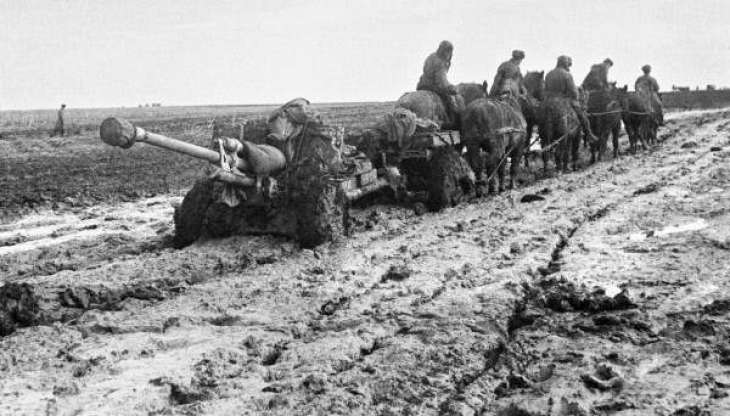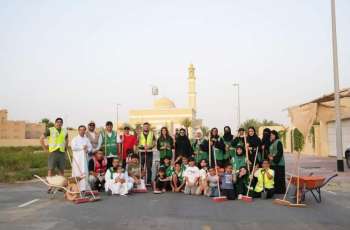Russian President Vladimir Putin will take part on Tuesday in the opening of a monument to Soviet soldiers who fought in the fierce Battles of zhev between 1942 and 1943 in World War II
RADCHENKO (Pakistan Point News / Sputnik - 30th June, 2020) Russian President Vladimir Putin will take part on Tuesday in the opening of a monument to Soviet soldiers who fought in the fierce Battles of zhev between 1942 and 1943 in World War II.
Soviet historians tended to consider the 1942-1943 hostilities at the so-called Rzhev Salient as several separate operations, not a single battle. Modern Russian experts often call all the operations in the area during this period the single Battle for Rzhev.
Nazi Germany suddenly attacked the Soviet Union on June 22, 1941, and using its favorite Blitzkrieg strategy managed to inflict many devastating defeats to the Red Army, which faced the threat of full collapse in November 1941. As part of the offensive on Moscow, in October 1941, the German troops (Wehrmacht) seized the Russian towns of Rzhev and Kalinin (currently, Tver).
However, in December, the Wehrmacht exhausted its offensive potential and, suffering from extremely cold weather, supply shortages and a front line that was too long, failed to take Moscow. Moreover, the Red Army, using fresh forces from Siberia, launched a successful counteroffensive on the German troops, forcing them to retreat from the advanced positions near Moscow. In-mid December, the Red Army defeated Germany near Kalinin, liberating the city from the enemy.
When the Soviet offensive near Kalinin came to end, the German troops found themselves at new defensive positions, forming the big salient, with its border lying along the towns of Demidov and Sychyovka in the Smolensk Region, Bely, Olenino, Rzhev and Zubtsov in the Kalinin Region (currently the Tver Region), and Yukhnov in the Kaluga Region. The town of Vyazma, located in the Smolensk Region, lied in the heart of the salient and, being a major railway juncture, played a key role in supplying the German Group Army Center.
The Rzhev Salient was critical for both the Wehrmacht and Red Army as, on the hand, it was a very comfortable position for Germany to launch a new offensive on Moscow but, and on the other hand, was a vulnerable position where huge Nazi troops were concentrated.
FIRST SOVIET OFFENSIVE (JANUARY-APRIL 1942)
The Wehrmacht did not have enough time to fortify its positions on the new salient, and the Red Army decided to cut off the troops within the salient from the main enemy forces. The success of this operation would mean the destruction of the most powerful forces of the Group Army Center and would put the whole German army on the brink of collapse. In fact, it was a chance to inflict a decisive defeat on Germany.
The start of the offensive was successful for the USSR, as the Red Army forced the Wehrmacht to leave some of its advanced positions. Afterward, some formations of the Soviet Army managed to break the weakened German defense positions on the flanks of the Rzhev Salient and infiltrate in the rear of the Wehrmacht.
Following this move, the Red Army needed to complete the final task cut off the railway in Vyazma to fully encircle the German troops. Unfortunately, some tactical mistakes, supply shortages and the fierce resistance of the Wehrmacht prevented the Soviet forces from succeeding. Moreover, a new commander of the German troops deployed to the Rzhev Salient, Walter Model, conducted several small counteroffensive operations, defeating the infiltrated Soviet troops.
In April, the Red Army could not continue the offensive anymore. It failed to liberate Rzhev and encircle the main German troops in the salient, but managed to seize advanced positions around the town of Zharkovsky, forming a smaller Soviet salient in Germany's Rzhev salient. During the operation, the Soviet army lost several hundreds of thousands of people who were killed, injured or went missing.
MODEL STRIKES BACK (JULY 2-20, 1942)
After the Soviet failure, the Wehrmacht managed to fortify its positions on the Rzhev Salient.
Both Germany and the USSR were preparing for new offensives: the Germans wanted to destroy the Zharkovsky Salient, while the Red Army the whole Rzhev Salient. As the Soviet salient was smaller, Model managed to finish the preparations earlier and on July 2 the Germans attacked the Red Army near Zharkovsky from their positions in Olenino and Bely in Operation Seydlitz.
Despite the fierce resistance, the Soviet troops were encircled and destroyed, leaving some 60,000 servicemen killed or missing.
SECOND SOVIET OFFENSIVE (JULY-OCTOBER 1942)
The Soviet Army completed its preparation for an offensive and, despite the utter defeat in Zharkovsky, launched a new attack on the salient. The Red Army believed that it would also deflate alleged German plans to seize Moscow, but these expectations turned out to be futile, as the Wehrmacht had no plans to attack the Soviet capital and instead launched a full-scale offensive in the South in hopes of establishing control over oil fields in the Caucasus.
The Red Army faced well-prepared German defensive positions on the Rzhev Salient and the only significant achievement of the operation was the liberation of Zubtsov on August 23, 1942. The Rzhev Salient remained in the hands of Germany. The Soviet Union lost about 200,000 troops in this operation, while Nazi Germany only some 45,000.
At the same time, the Soviet offensive urged the Wehrmacht to send more troops to the Rzhev Salient instead of the southern operations, so the importance of this battle should not be underestimated.
THIRD SOVIET OFFENSIVE, OPERATION MARS (NOVEMBER-DECEMBER 1942)
The German command expected the Red Army to be capable of conducting only one major offensive in the winter of 1942-1943 and, from their point of view, the Rzhev Salient was the goal of this operation. However, the Soviet Union managed to prepare two big offensive operations: indeed on the Rzhev Salient (Operation Mars) and against the Axis troops near Stalingrad (currently, Volgograd, Operation Uranus) where the Wehrmacht was not prepared to defend its positions.
Once again, the Soviet troops managed to break through the frontline in several positions near Rzhev but the advancing formations were defeated in the German counteroffensive operations.
The Red Army lost 70,000-100,000 troops, who were killed or missing, and much more injured, while the Wehrmancht's losses amounted to 40,000 people.
Despite the clear defeat of the Red Army, it managed to block a significant number of German troops near Rzhev, which prevented the Wehrmacht from sending additional reinforcements to Stalingrad, where big Axis forces were encircled as a result of Operation Uranus.
FOURTH SOVIET OFFENSIVE, LIBERATION OF RZHEV (MARCH 1943)
The Battle for Stalingrad resulted in the collapse of the southern German flank and marked the tipping point in World War II. Germany needed more forces to stop the Red Army in the South and did not have enough resources to hold the Rzhev Salient. At the same time, the Red Army still had the same goal as a year earlier: to encircle and fully destroy the German troops in the salient.
The situation deteriorated even further for the Wehrmacht on January 17, 1943, when the Soviet Army recaptured the city of Velikiye Luki in the Pskov Region, raising the threat of encirclement for the Wehrmacht.
On March 1, 1943, Model started Operation Büffel to evacuate the German troops from the salient to shorten the frontline by some 330 kilometers (over 200 miles) and fortify the new defense line of Dukhovshchina-Dorogobuzh-Spas-Demensk.
The Red Army launched an offensive to encircle the retreating German forces but failed to do so. On March 3, the Soviet troops entered the fully devastated town of Rzhev and by the end of the month, the territory of the salient was fully retaken by the USSR. While retreating, the Germans committed multiple war crimes, killing civilians and taking them for forced labor to Germany, as well as fully destroyed the infrastructure in the area.
During Operation Büffel, the Red Army lost some 40,000 people, who were killed, and some 100,000 injured, while the Wehrmacht's losses amounted to some 15,000 servicemen.
The successful retreat did not help Germany stabilize the military situation: in the summer of 1943, Model's 9th Army evacuated from the Rzhev Salient took part in the Battle for Kursk, which turned out to be disastrous for the Wehrmacht. Following the Battle for Kursk, the Wehrmacht could not resist the Red Army anymore and the war ended less than two years later with the fall of Berlin.
The Battles for Rzhev are not as widely known as, for example, the battles for Stalingrad, Kursk and Moscow. However, the operations on the salient had significant importance as they did not allow the Wehrmacht to launch a new offensive on Moscow. The entire amount of Soviet losses in the Battles for Rzhev exceeded 1.16 million servicemen, including about 400,000 killed, missing or captured.
In 2019, Russia released the "Rzhev" movie dedicated to one of the episodes of the first Soviet offensive on the salient.
Famous Soviet poet Aleksandr Tvardovsky wrote a poem about the fierce clashes near Rzhev in 1946:




